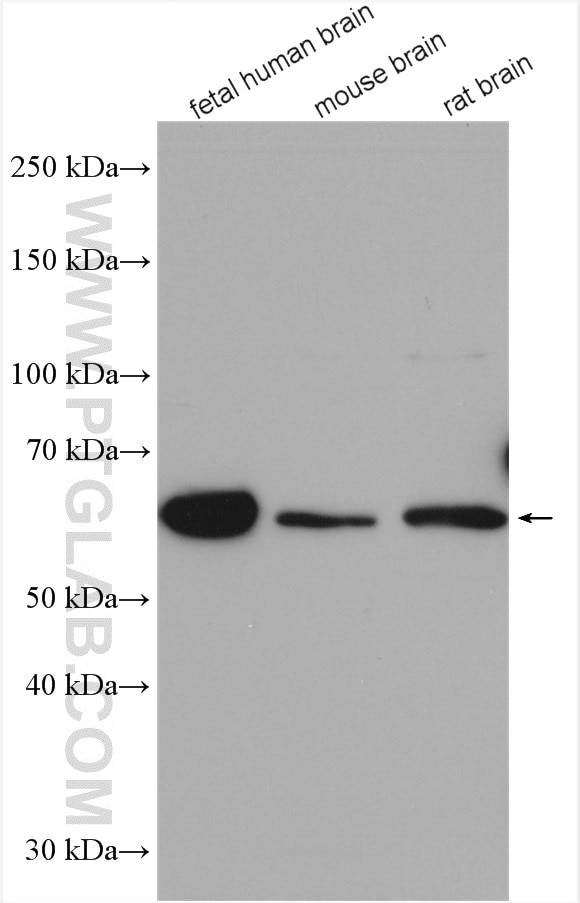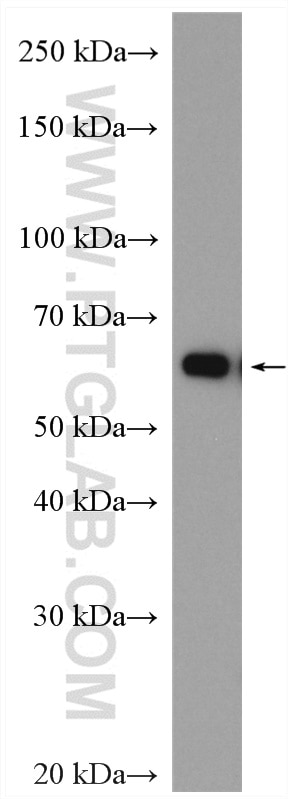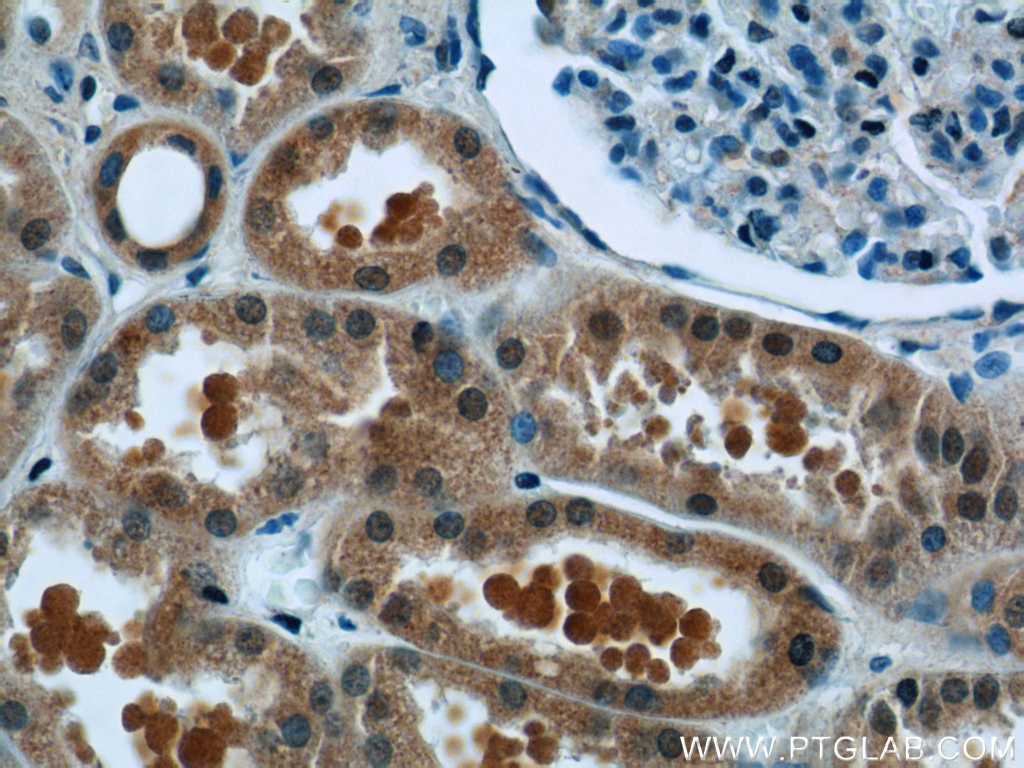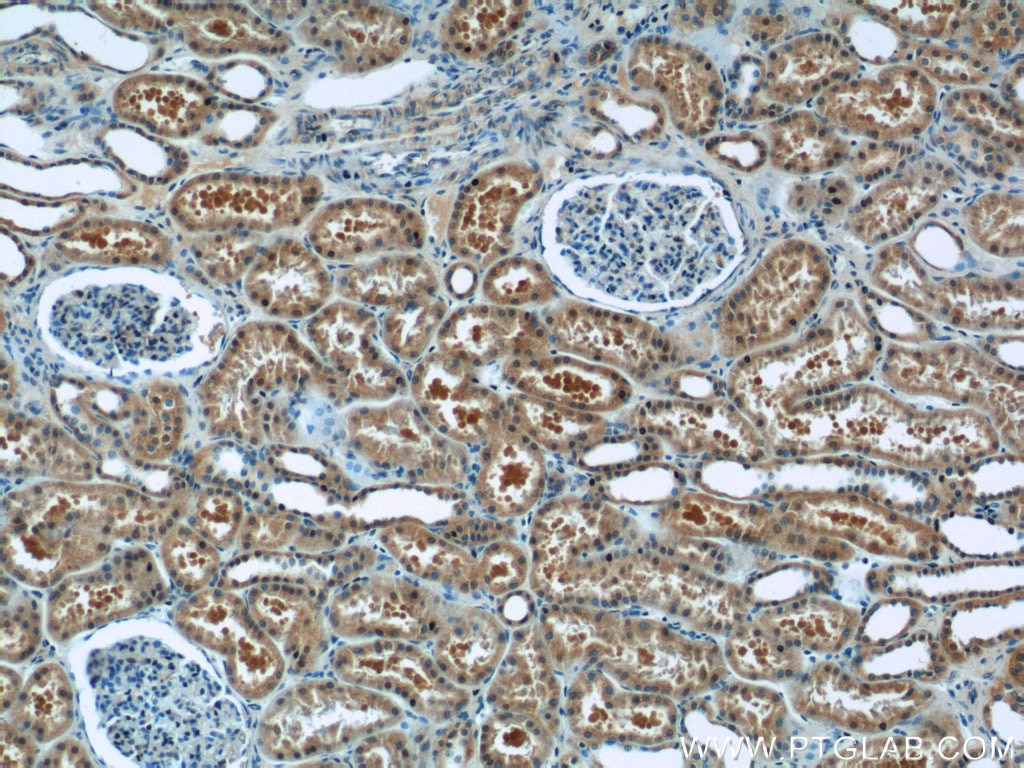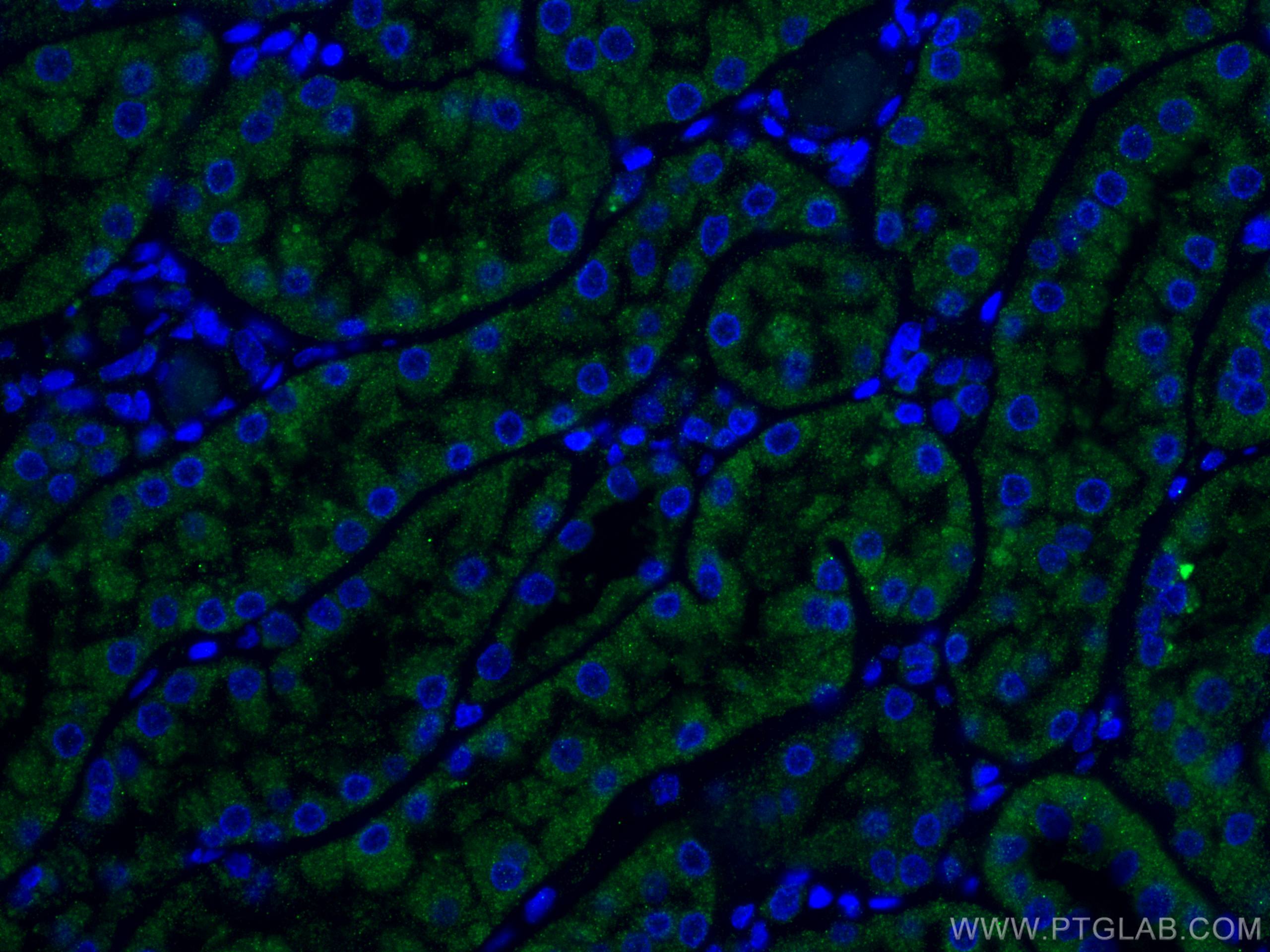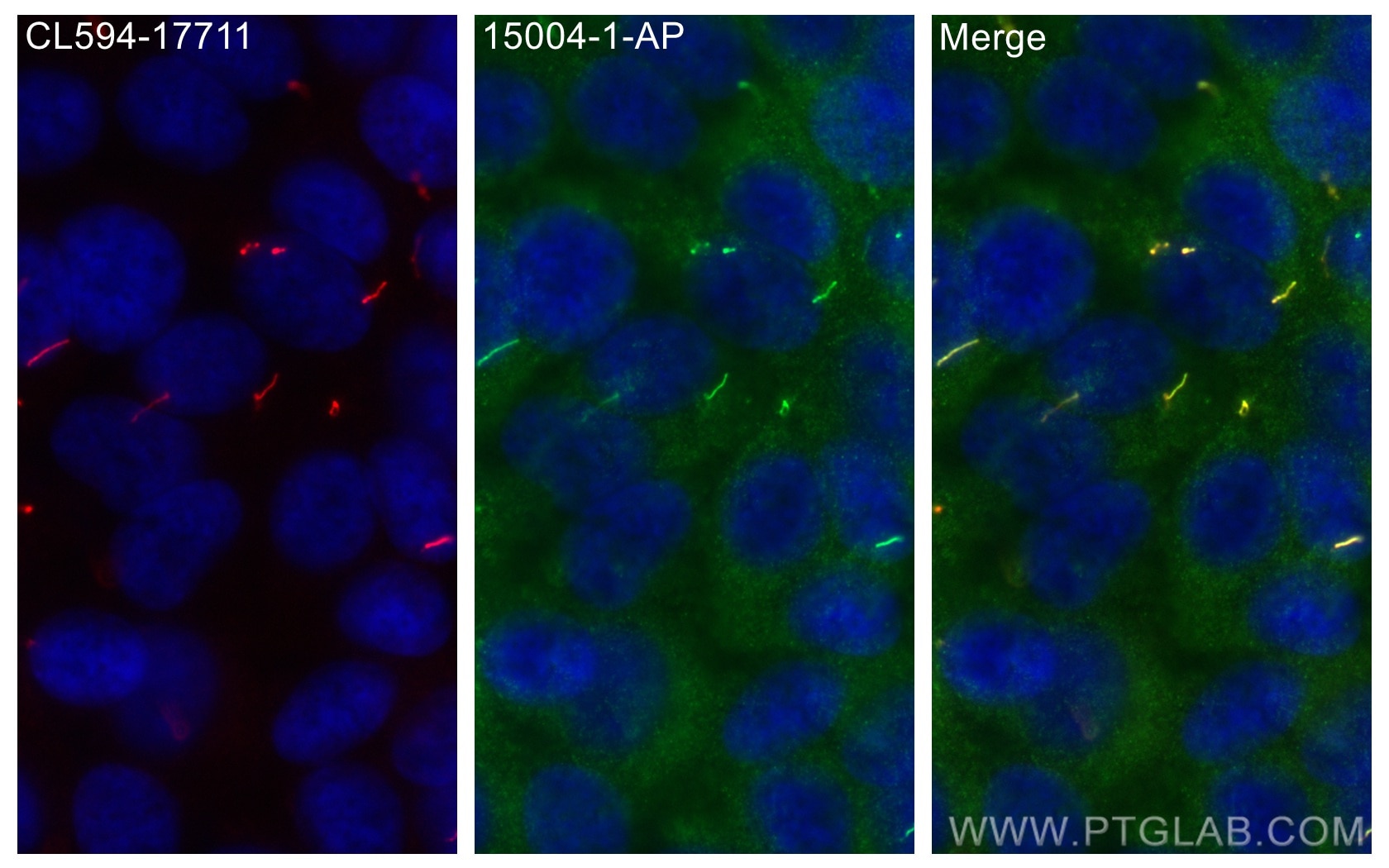TCTN1 Polyklonaler Antikörper
TCTN1 Polyklonal Antikörper für WB, IHC, IF/ICC, IF-P, ELISA
Wirt / Isotyp
Kaninchen / IgG
Getestete Reaktivität
human, Maus, Ratte und mehr (1)
Anwendung
WB, IHC, IF/ICC, IF-P, ELISA
Konjugation
Unkonjugiert
Kat-Nr. : 15004-1-AP
Synonyme
Geprüfte Anwendungen
| Erfolgreiche Detektion in WB | fetales humanes Hirngewebe, Maushirngewebe, Rattenhirngewebe |
| Erfolgreiche Detektion in IHC | humanes Nierengewebe Hinweis: Antigendemaskierung mit TE-Puffer pH 9,0 empfohlen. (*) Wahlweise kann die Antigendemaskierung auch mit Citratpuffer pH 6,0 erfolgen. |
| Erfolgreiche Detektion in IF-P | humanes Nierengewebe, hTERT-RPE1-Zellen |
| Erfolgreiche Detektion in IF/ICC | hTERT-RPE1-Zellen |
Empfohlene Verdünnung
| Anwendung | Verdünnung |
|---|---|
| Western Blot (WB) | WB : 1:500-1:1000 |
| Immunhistochemie (IHC) | IHC : 1:20-1:200 |
| Immunfluoreszenz (IF)-P | IF-P : 1:200-1:500 |
| Immunfluoreszenz (IF)/ICC | IF/ICC : 1:200-1:800 |
| It is recommended that this reagent should be titrated in each testing system to obtain optimal results. | |
| Sample-dependent, check data in validation data gallery | |
Veröffentlichte Anwendungen
| WB | See 5 publications below |
| IF | See 22 publications below |
Produktinformation
15004-1-AP bindet in WB, IHC, IF/ICC, IF-P, ELISA TCTN1 und zeigt Reaktivität mit human, Maus, Ratten
| Getestete Reaktivität | human, Maus, Ratte |
| In Publikationen genannte Reaktivität | human, Maus, Zebrafisch |
| Wirt / Isotyp | Kaninchen / IgG |
| Klonalität | Polyklonal |
| Typ | Antikörper |
| Immunogen | TCTN1 fusion protein Ag6099 |
| Vollständiger Name | tectonic family member 1 |
| Berechnetes Molekulargewicht | 64 kDa |
| Beobachtetes Molekulargewicht | 55-64 kDa |
| GenBank-Zugangsnummer | BC062611 |
| Gene symbol | TCTN1 |
| Gene ID (NCBI) | 79600 |
| Konjugation | Unkonjugiert |
| Form | Liquid |
| Reinigungsmethode | Antigen-Affinitätsreinigung |
| Lagerungspuffer | PBS with 0.02% sodium azide and 50% glycerol |
| Lagerungsbedingungen | Bei -20°C lagern. Nach dem Versand ein Jahr lang stabil Aliquotieren ist bei -20oC Lagerung nicht notwendig. 20ul Größen enthalten 0,1% BSA. |
Hintergrundinformationen
Tectonic-1, encoded by TCTN1 (TECT1) gene, belongs to the tectonic family of secreted and transmembrane proteins. Tectonic-1 is a component of the tectonic-like complex, a complex localized at the transition zone of primary cilia and acting as a barrier that prevents diffusion of transmembrane proteins between the cilia and plasma membranes. Multiple transcript variants encoding different isoforms have been found for this gene. Defects in TCTN1 are the cause of Joubert syndrome type 13 (JBTS13), a disorder presenting with cerebellar ataxia, oculomotor apraxia, hypotonia, neonatal breathing abnormalities and psychomotor delay.During neural tube development, mouse Tectonic is required for formation of the most ventral cell types and for full Hedgehog (Hh) pathway activation. Epistasis analyses reveal that Tectonic modulates Hh signal transduction downstream of Smoothened (Smo) and Rab23.
Protokolle
| PRODUKTSPEZIFISCHE PROTOKOLLE | |
|---|---|
| WB protocol for TCTN1 antibody 15004-1-AP | Protokoll herunterladen |
| IHC protocol for TCTN1 antibody 15004-1-AP | Protokoll herunterladenl |
| IF protocol for TCTN1 antibody 15004-1-AP | Protokoll herunterladen |
| STANDARD-PROTOKOLLE | |
|---|---|
| Klicken Sie hier, um unsere Standardprotokolle anzuzeigen |
Publikationen
| Species | Application | Title |
|---|---|---|
Nat Genet A transition zone complex regulates mammalian ciliogenesis and ciliary membrane composition. | ||
Nat Genet Mutations in DZIP1L, which encodes a ciliary-transition-zone protein, cause autosomal recessive polycystic kidney disease. | ||
Nat Cell Biol A ciliopathy complex at the transition zone protects the cilia as a privileged membrane domain. | ||
Nat Cell Biol CEP162 is an axoneme-recognition protein promoting ciliary transition zone assembly at the cilia base. | ||
Sci Adv Ciliopathy protein HYLS1 coordinates the biogenesis and signaling of primary cilia by activating the ciliary lipid kinase PIPKIγ. | ||
Nat Commun Microtubule asters anchored by FSD1 control axoneme assembly and ciliogenesis. |
